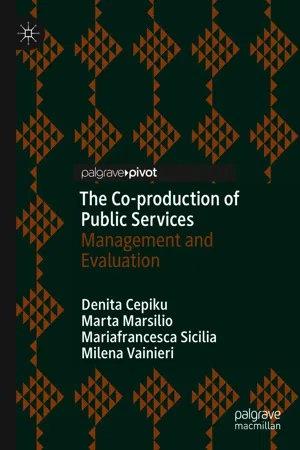1.1 Co-Production Definitions
Co-production has received attention from both academics and practitioners working in the public sector since the 1970s. The concept of co-production was originally developed in a workshop on ‘Political Theory and Policy Analysis’ at Indiana University in 1973. Co-production drew great interest among public administration scholars in the US in the 1970s and 1980s (Parks et al. 1981). It was also studied in the context of industrial and service markets and, in the 1990s, in consumer markets, where the emergence of the ‘customising consumer’ who takes an active role in the production process was witnessed (Abeysekera et al. 2015). More recently, the work of Prahalad and Ramaswamy (2000, 2002, 2004a, b) and Vargo and Lusch (2004, 2006) on value co-creation and the service dominant logic of marketing has driven the idea of co-production.
According to Ostrom (1996), co-production is the process through which input—used to provide a good or a service—is contributed by individuals who are not in the same organisation. It has been used with a large variety of meanings and is considered a relatively heterogeneous concept (Verschuere et al. 2012).
With respect to the ‘co-’ side of co-production, Nabatchi et al. (2017) identified state actors (i.e., government agents serving in a professional capacity) and lay actors (i.e., members of the public, serving voluntarily as citizens or users) as working together in any phase of the public service cycle (i.e., commissioning, design, delivery, and assessment). In particular, they distinguish three levels of co-production: individual, group and collective. The main differences between these three levels of co-production are related to the role played by lay actors and the type of benefits they generate and receive through co-production (Nabatchi et al. 2017).
Individual co-production implies that a state actor and a lay actor (a client or a customer) work directly with each other. The benefits of the co-production activity tend to be personal for the lay actor (see also Brudney and England 1983) but there may also be social benefits for the wider community.
Group co-production is characterised by the presence of one or more state actors working directly and simultaneously with a specific cluster or category of lay actors who share common interests.
Collective co-production is defined as one or more state actors (within a single organisation or across multiple organisations) working directly and simultaneously with several lay actors to address one or more related issues. Differently from group co-production, where lay actors are defined as a specific segment of the population, which leads to personal benefits for the group members, collective co-production involves diverse members of the community such as citizens, volunteers, and non-governmental entities (see also Alford 2014; Bovaird 2007) and benefits are shared by the entire community (see also Brudney and England 1983).
Another classification based on the ‘co-actors’ side was proposed by Alford (2014). He distinguishes three kinds of co-producers: consumers, suppliers, and partners. Consumers stand at the end of the service delivery process and act as co-producers in their secondary role, whereas suppliers and partners do so as part of their primary role.
With respect to the ‘production’ side of co-production, it is possible to distinguish four types of co-production according to the specific phase of the service cycle in which state actors and lay actors work together.
Co-commissioning is defined as the identification and prioritisation of the necessary public services, outcomes, and users. It is thus prospective, such as in the identification of budget priorities in order to allocate specific amounts of resources in participatory budgeting experiences (Barbera et al. 2016; Bovaird 2007).
Co-design involves users and communities participating in the creation, planning or arrangement of public services (Bovaird and Loeffler 2012), similarly to an approach based on direct citizen participation (Nabatchi and Amsler 2014; Nabatchi and Leighninger 2015). It can be prospective or concurrent, such as in the case of a professional social services unit working with elderly people to create opportunities for “interdependent” living (Bovaird and Loeffler 2012; Willis and Bovaird 2012). It includes user innovation (Bonomi Savignon and Cepiku 2018; De Rosis et al. 2020).
Co-delivery is related more to the traditional view of co-production and consists of joint activities between the government and lay actors, aimed at providing or improving public services (Alford and O’Flynn 2012; Thomas 2013), it is thus concurrent in nature. ...
